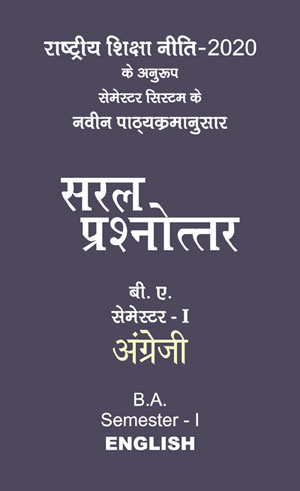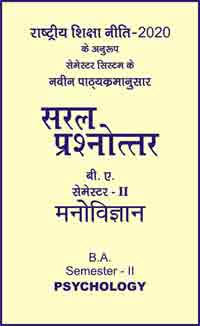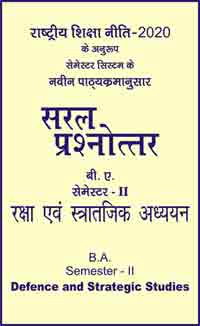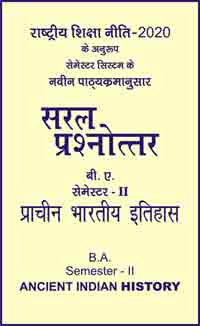|
बी ए - एम ए >> बीए सेमेस्टर-1 अंग्रेजी बीए सेमेस्टर-1 अंग्रेजीसरल प्रश्नोत्तर समूह
|
5 पाठक हैं |
|||||||
बीए सेमेस्टर-1 अंग्रेजी के प्रश्नोत्तर
Question- Write about Bhattacharya's concept of Fiction.
Ans-
Bhattacharya's Concept of Fiction:Bhattacharya is a realist with a social purpose. In his fiction, he has amply proved his ability to reconcile demands of art with his sense of social commitment. He is advocate of the idea of "art for life's sake" Any work without social purpose is thoroughly meaningless to him. He says:
"Art is not necessarily for art's sake
purposeless
art and literature which is much in vogue
does
not appear to me a sound judgement.
He maintains that creative literature should be intructive to the reader without being dedactic and pedantic. He thinks that a genuine work of literature deals with themes related to human miseries and predicament.
He opines that it is possible to produce a work of fiction based on the contemporary events and conditions, though it may appear to some that current happenings incapacitate the writer to adopt objective stance on account of their immediacy. He earnestly feels that such events alone can furnish the raw-material to create a work of art. The writer's sharp sensibility is more alive to them. He writes:
"It has been argued that the novelist
should not.
draw his material from contemporary reality,
since he is too close to it to be able to read its
meaning and assess its inward nature.
This is absurd."
This view about the viability of contemporary events as suitable material for fictional writing is again stated by him when he says. "The history need not wait for fifty years before it is declared suitable for fictional projection." He is not against the treatment of sex in fiction. He considers sex an inseparable part of life and since art is basically related to the revelation of the truth of life, its omission will tantamount to an incomplete partrayal of the realities of life. But, he is averse to direct treatment of sex in the novel. He wants it to be treated in a suggestive manner to acquire artistic value
This flow of cheap paperback, vulgar, low-
taste
books revelling in sex description cannot be welcomed. I have a revulsion for
Them. But look at Lawrence. He creates a whole world of this much tabooed feeling and yet the descriptions are most beautiful and excel in their lyrical quality.
Bhattacharya has liberal views about techniques employed in fiction. "As for as his art is concerned, it is fundamentally conventional in terms of techniques but he does not appose new techniques of fiction by other writers. According to him, a writer is free to choose any style that suits his theme and talents. With regard to language, he again gives full liberty to a writer to choose any medium of expression in which he is most comfortable. His views on the creative process are skin to those of the romantics. In his opinion, a work of art is spontaneous in nature, it is produced when a writer feels a strong creative urge. Often characters develop independent of the writer's preconceived design and this holds true for the entire plan of a work of art Bhattacharya says:
"But, when I start writing, it is not I, but characters and situations that compel
me to be
led by them. It is they who should decide the
way they should end. The end of the story in
my case, is never the one which I had in my mind in the beginning."
Place of Bhattacharya in Indo-Anglian Fiction: The international recognition accorded to Indo-Anglian literature is indictive of the success achieved by the Indian writers who have expressed Indian sensibilities in a medium foreign to the ethos of Indian soil. Though Bhattacharya is not among the foremost fiction writers, yet, he has made a distinct name in Indo-Anglian fiction for himself. He occupies an intermediate position between the Big Tree R.K. Narayan, Mulk Raj Anand and Raja Rao on the one hand, and Nayantara Sehgal, Anita Desai, Kamala Markandaya, Ruth Prawar Jhabvala on the other. Unlike many other writers of the 20th century, he is a socially committed artist. It accounts for his president concern with the themes of poverty, exploitation, hunger, suffering, casteism, East-West encounter, etc. He is a progressive writer who is keen on bringing about a change in the thinking and attitude of the people to help them face the challenge of the changing times.
Hunger has been a persistent thematic concern of Bhattacharya. He treats it in its multitudinous dimensions. No other Anglo-Indian writer has presented human tragedy on such a scale and with such an insignt as does Bhattacharya. Mulk Raj Anand and Kamala Markandaya deal with the theme of hunger in their novels like 'Coolie', 'Untouchable', Nector in a Sieve' and 'A Handful of Rice' but none of them can excel Bhattacharya's treatment of it in its varied aspects. His famous novel 'So Many Hungers' is a fine work of literature which bears the writer's deep observation of Indian society. In the novel, hunger is treated in its varied aspects of starvation of people, their hunger for money, their hunger for sex, their hunger for power, for recognition, for fame, wife's hunger for the love of her husband, women's hunger, social freedom, and so on.
Many Indo-Anglian novelists have portrayed life in Indian villages. They have set their novels in rural India for the simple reason that villages constitute more than seventy percent of Indian social life and can provide more meaningful view of India. K.S. Venkataraman's 'Kandan the Patriot' and Murgan the Tiller', Mulk Raj Anand's The Old Man and the Cow' and The Village' are some novels treating the lives of the poor villagers on a substantial scale. The novels of Bhattacharya are by and large set in different villages of Bengal and concerned with the clash of urban and rural values. The vision of the novelist finally emerging at the end is one of healthy synthesis between positive aspects of the urban and the rural. The Goddess Named Gold' is one of the finest novels on Indian village life to come in years.
The theme of conflict between tradition and modernity is another important thematic concern of Bhattacharya's fiction. His Music For Mohini' deals with this theme and finally presents a reconciliation between tradition and modernity.
The theme of Indian independence has always attracted Indo-Anglian writers. Khwaja Ahmad Abbas in 'Inqvilab', Khushwant Singh in Train to Pakistan' and 'I shall Not Hear The Nightingale' and Magaonkar's in 'A Bend in the Ganges' have treated the theme of Indian independence and the horrors of partition. But these novels do not explore the depth at human emotions as the way Bhattacharya's 'So Many Hungers !' and 'He Who Rides the Tiger' do.
He is a past master of the art of portraying human emotions to a nicety. Be it the anguish of a tormented soul, or a feeling at rootlessness, or an aspiration for country's freedom, or a sense of defeat or exultation, very few Indo-Anglian writers can hope to match Bhattacharya's penmanship in delineating them. In the progress of the action, Bhattacharya displays an uncarry mastery in fusing together intellectual dialectics and emotional depths. Bhattacharya is at home in painting every conceivable shade of human emotions. He superbly handles the romantic relationship between Sunita and Bhaskar, a wife's emotional starvation in Mohini's character, Kajoli's spirit of sacrifice, Meera's all consuming concern for the poor. Such varied tones of emotions are missing in Mulk Raj Anand or Khushwant Singh.
Bhattacharya is a realist and his characters and their situations are taken from life. He does not indulge in metaphysical abstractions like Raja Rao, nor does he exercise comic imagination of R.K. Narayan, nor does he dabble in pornographic descriptions like Khushwant Singh. He presents both the rural and the urban sides of India. His treatment of life is deep, with a measure of pathos reminding us of Charles Dickens. He draws his characters from different sections of society. An important fact about his novels is that he is concerned with an individual's possibility of success in life. His social commitment is not towards the economic well being of society alone, he is also keen to intellectually change the social structure.
Not with standing an indelible influence of Tagore, Bhattacharya's novels are quite different from the works of the great Bengali writer. A writer of Bhattacharya's vision is highly optimistic in striking contrast to Tagore. His novels envisage a bright future for India inspite of many contradictions in its social fabric.
Bhattacharya's world wide fame as a writer owes in a large measure to his style. His language is equally alive to the Indian ethos and responsive to stylistic expedients of English Language. Like many established Indo-Anglian writers he successfully exploits the language to serve his artistic requirements. His language carries a distinctive flavour of Indianess. R.K. Narayan writes in a very simple English and does not experiments with style, Raja Rao breaks the English syntax to adapt it to his requirements, and Bhattacharya coins new words and translates Indian phrases, proverbs, idioms into English to express Indian sensibility. Bhattacharya employ them in the dialogues. He, comes out successful in conveying the real spirit of the Indian society through a foreign medium. He is a master of simple and smooth style without any pretensions to sublimity. He is capable of expressing what he wants to. He says:
"Indian writing in English has been a decisive factor in redressing false presentation by foreign story tellers who, with their limited possibilities of true experience, have seen only the surface of our way of like, failing to reach deeper into our spirit."
Bhattacharya's plots are well constructed in most of the novels. This he One accomplishes despise being tentative in planning his novels. characteristic feature of his plots is that they observes time space relationship and proceed in a logical sequence.
His art of female characterization scores over that of male characterization. His female characters, generally speaking, though idealistically drawn, appear convincing in many respects. They occupy major options in the plots of the novels. Their appeal lies in their individuality and they also attain symbolic significance. They act and behave not as automator but as thinking individuals who can comprehend the demands of their situation.
|
|||||
- Question- Discuss Sri Aurobindo's contribution to Indo-Anglian poetry.
- Question- Discuss Sri Aurobindo as a mystic poet.
- Question- "Tagore is a lyric poet par excellence." Comment.
- Question- "Tagore is not a poet of Bengal, but of India and the world." Discuss.
- Question- Write a note on life and works of K. S. Venkataramani.
- Question- Describe Venkataramani's reflection on village life which he presented in his novels.
- Question- Write the life and writing style of Bhabani Bhattacharya.
- Question- Write about Bhattacharya's concept of Fiction.
- Question- Consider R. K. Narayan as a novelist.
- Question- Describe Indianess in R. K. Narayan's novels.
- Question- Write a note on Mulk Raj Anand's place in English Literature.
- Question- Write a note on the main influences on Mulk Raj Anand.
- Question- What is Mulk Raj Anand's contribution to the development of Indo-Anglian fiction?
- Question- What are the general themes of the novels of Mulk Raj Anand?
- Question- Write a short note on Mulk Raj Anand as a social critic of downtrodden society.
- Question- What is the contribution of Mulk Raj Anand to Indian English Literature?
- Question- Write a detailed life-sketch of Sarojini Naidu. Also describe in her works and contribution towards Indian Writing English.
- Question- Write life and career details of Kamala Markandaya in detail.
- Question- Write a note on the contribution of Kamala Markandaya towards the growth of Indian English Literature.
- Question- Write a comment on Kamala's 'Art of Narration".
- Question- Write a note on life and works of Nayantara Sahgal.
- Question- Write a list of the works of Nantara Sahgal?
- Question- Which is the last novel of Nayantara Sahgal?
- Question- Explain Plot in a Short Story.
- Question- What is characterization in a short story? Discuss the types & importance of characterization.
- Question- What is the meaning of Narrative Techniques? Explain types of narrative technique with examples.
- Question- Write a note on the Narrative structure and its types. Discuss in brief.
- Question- What is prose and what types of prose are found in English Literature?
- Question- What is short story?
- Question- What is an essay?
- Question- Discuss novel.
- Question- What is autobiography?
- Question- What is biography?
- Question- What is play?
- Question- What is Travelogue ? Mention two books that belong to this class of literature.
- Question- Discuss Pamphlet.
- Question- What is biography? Name two famous biographies in English.
- Question- What is an informal essay? Who is a well-known informal essayist of English Literature?
- Question- Distinguish between formal and personal essay. Give examples.
- Question- How would you distinguish between early eighteenth century and early nineteenth century style in literary essay writing?
- Question- What is an autobiography? How is it different from a biography?
- Question- What is theme? Explain in detail.
- Question- What do you know about Sentence Pattern?
- Question- What do you know about Imagery and Explain the types of Imagery?
- Question- What is Tone or Mood? Elaborate it in detail.
- Question- What is the definition of 'Point of View' ?
- Question- What do you understand by Humour ? Also write the characteristics and kinds of it.
- Question- What is the meaning of Analogy?
- Question- What do you mean by Anecdotes?
- Question- What do you mean by Aphorism?
- Question- What are the definitions of Inversion?
- Question- How do you define a theme?
- Question- What is the theme in a story?
- Question- What are the main themes?
- Question- What is imagery and its example?
- Question- Define Pathos in literature.
- Question- What are the origins of Pathos ?
- Question- What is Pathos?
- Question- What are the models of humour?
- Question- What do you mean by Antithesis?
- Question- What do you mean by diction?
- Question- O. Henry's The Last Leaf is the story of perseverance. Discuss.
- Question- Describe the character of Sue in the story 'The Last Leaf.
- Question- How does Johnsy deals with her illness?
- Question- Explain the theme and the title of the story "The Last Leaf."
- Question- Attempt a detailed character sketch of Iona.
- Question- Comment on the setting, theme and tone of the story.
- Question- What message does the story 'Lament' provide?
- Question- Analyse the story with reference to its relevance in the present context.
- Question- Comment on the symbolism in the short story "The Lament'.
- Question- Who is Iona ? What impression of his character do you get from the story?
- Question- Why is it important for Iona to be able to tell someone about his son's death?
- Question- Comment on the indifference that meets Iona's attempts to share his grief with his fellow human beings.
- Question- How does the horse serve as a true friend and companion to Iona ?
- Question- Empathy and understanding are going out of modern society. The individual experiences intense alienation from the society around him or her. Comment.
- Question- Explain in detail the life and work of Guy de Maupassant.
- Question- What is the summary of the story The Terror' by Guy de Maupassant?
- Question- What is the theme of the story The Terror' and describe it in your own words?
- Question- Write the Introduction of the story The Terror'.
- Question- What is the point of view in this story "The Terror' by Maupassant?
- Question- What is meaning of 'Fear' and 'Sense' in this story The Terror?
- Question- What is in Mental Disorder in this story The Terror'?
- Question- The writer presents his attitude towards women in this story "The Terror'. Explain it.
- Question- What is the summary of the story The Barber's Trade Union' by M. R. Anand.
- Question- Who is the Protagonist of the stoey The Barber's Trade Union"?
- Question- Why was Chandu not good at doing sums at school?
- Question- Why did the narrator's mother constantly dissuade him to play with Chandu?
- Question- What is the meaning of Trade Union?
- Question- What is the summary at the story 'Under The Banyan Tree' by R. K. Narayan?
- Question- Describe the village Somal.
- Question- Who is Nambi in the story 'Under the Banyan Tree' ?
- Question- What do you understand by 'enchanter"? Why does the author call Nambi an 'enchanter"?
- Question- What is irony? How does Narayan use it in this story?
- Question- "It was story building on an epic scale." What do you understand by this statement? Elaborate.
- Question- Why does Nambi says, "...... Age, age. What is my age? it has come on suddenly ?"
- Question- Describe Nambi's life after he stops telling stories? Do the villagers reject him?
- Question- Explain "terrible sense of his insignificance" which Ravi feels at the end of the story. What lesson has he learned about life?
- Question- Discuss the various themes in the story.
- Question- Comment on the plot of the story.
- Question- Attempt a detailed character sketch of Ravi.
- Question- What do you know about the setting of the story, 'Games At Twilight'?
- Question- Who is Raghu ? What do you assess about his character?
- Question- Describe the garden in which the children are playing hide and seek.
- Question- What are your impressions of the following children from the first section of the story?
- Question- How is the shed described? Why are these details important to understanding Ravi's feelings?
- Question- How did Ravi lose without being caught?
- Question- Analyse the theme of Bacon's eassy 'Of Studies.'
- Question- Write an essay on Bancon's prose style.
- Question- Critically appreciate Bacon's 'Of Studies'.
- Question- What message does Bacon try to put across in the essay 'Of Studies'?
- Question- The essays of Bacon are concerned only with worldly wisdom and the art of success. Discuss.
- Question- What type of books are recommended by Bacon for studies?
- Question- What are the bad effects of studies according to Bacon?
- Question- How does Bacon justify that various defects of mind can be cured by particular studies?
- Question- Who is the author of 'Of Studies'?
- Question- According to Bacon what is the use of studies?
- Question- How studies are used by different kinds of people?
- Question- Bacon says 'Studies pass into character', explain it.
- Question- Give two features of Bacon's style.
- Question- Quote one sentence Bacon's 'Of Studies', that you like most.
- Question- Ennumerate the advantages of reading books.
- Question- Give two reasons why do you like an essay.
- Question- How, according to Bacon, do history, poetry, mathematics, natural philosophy, moral philosophy and logic and rhetoric help one to improve one self?
- Question- Write a brief note on the life and work of Charles Lamb.
- Question- Give a critical estimate of Lamb as an essayist.
- Question- What are the salient features of Lamb's prose-style?
- Question- Discuss autobiographical element in the essays of Lamb.
- Question- Write a note on Lamb's as a writer of humour and pathos.
- Question- Write a note on Lamb as a lover of peace.
- Question- What happened when Lamb awakened from his dream?
- Question- How does Charles Lamb present his brother John Lamb?
- Question- Examine in short "Dream Children" as a specimen of Dream Literature.
- Question- Analyse the striking qualities of Addison as a satirist ?
- Question- Compare Addison and Steele as critics of the life and manners of their age.
- Question- Write a note on Addison's prose style.
- Question- Briefly analyse Addison's prose style.
- Question- Who was Sir Roger?
- Question- Why is said that Sunday clears away the rest of the whole week?
- Question- Write a note on use of wit, irony and fancy in the essay of Addison?
- Question- What is the significance of a Country Sunday?
- Question- Give a brief note on Addison as a innovator of periodical essays.
- Question- Who is the author of the essay 'Sunday in the Country'.
- Question- Give an introduction of 'Profession For Women' by Virginia Woolf.
- Question- Critical appreciation to 'Profession For Women' by Virginia Woolf.
- Question- What are the main obstacles in Profession For Women' by Virginia Woolf?
- Question- What is the main point of the essay Profession for Women'?
- Question- Describe the full life detail of A.P.J. Abdul Kalam.
- Question- Write about the famous book "Ignited Minds" of Kalam and its qualities.
- Question- What is an early life and education of Amartya Sen?
- Question- What do you know about Amartya Sen's Career?
- Question- What do you know about Amartya Sen's personal life?
- Question- Write about Amartya Sen's award and honours.
- Question- Give an Introduction to The Argumentative Indian', written by Amartya Sen, in your words.
- Question- How does Amartya Sen portray Tagore in his essay Tagore and His India"?
- Question- What did Rabindranath Tagore do for India?
- Question- What do you mean by Power Point Presentation?
- Question- What are benefits of Power Point?
- Question- Discuss power point presentation.
- Question- What is presentation? How are they created?
- Question- Give the importance of letter writing. What are the types of letters? What are the qualities of a good letter?
- Question- Make an application to the Principal P. P. N. College Kanpur for giving you a full concession in fee.
- Question- Write an application to the Principal of your college requesting him to allow you to change one of your subjects.
- Question- Write an application to the District Supply Officer for supplying building material.
- Question- Write an application to the Principal of your college requesting him to grant you leave for four days so that you may attend the marriage ceremony of your elder sister.
- Question- Discuss personal letter. Name the parts of it.
- Question- What do you understand by an Inquiry letter?
- Question- What is complaint letter and also describe the format and examples of it.
- Question- Describe Right to Information letters in detail and also tell the steps to file it.
- Question- Write a note on enquiries, quotations and orders.
- Question- Write a note on complaint and adjustment letter.
- Question- Give the form and contents of an application letter.
- Question- Discuss Resume writing.
- Question- Write down the do's and dont's while preparing your resume.
- Question- Write a note on covering letter of resume.
- Question- Write short note on the following- (a) Bio-data (b) Application blanks.
- Question- Pen down a model of an application to the Vice Chancellor of a University for the post of Assistant Professor of Education.
- Question- Write a detailed note on Online Writing.
- Question- What is a Blog?
- Question- What are the purpose of a blog?
- Question- What is Blog Structure?
- Question- What is blogging?
- Question- What is Content Writing?
- Question- Write the types of Content Writing.
- Question- What is the basics of content writing?














